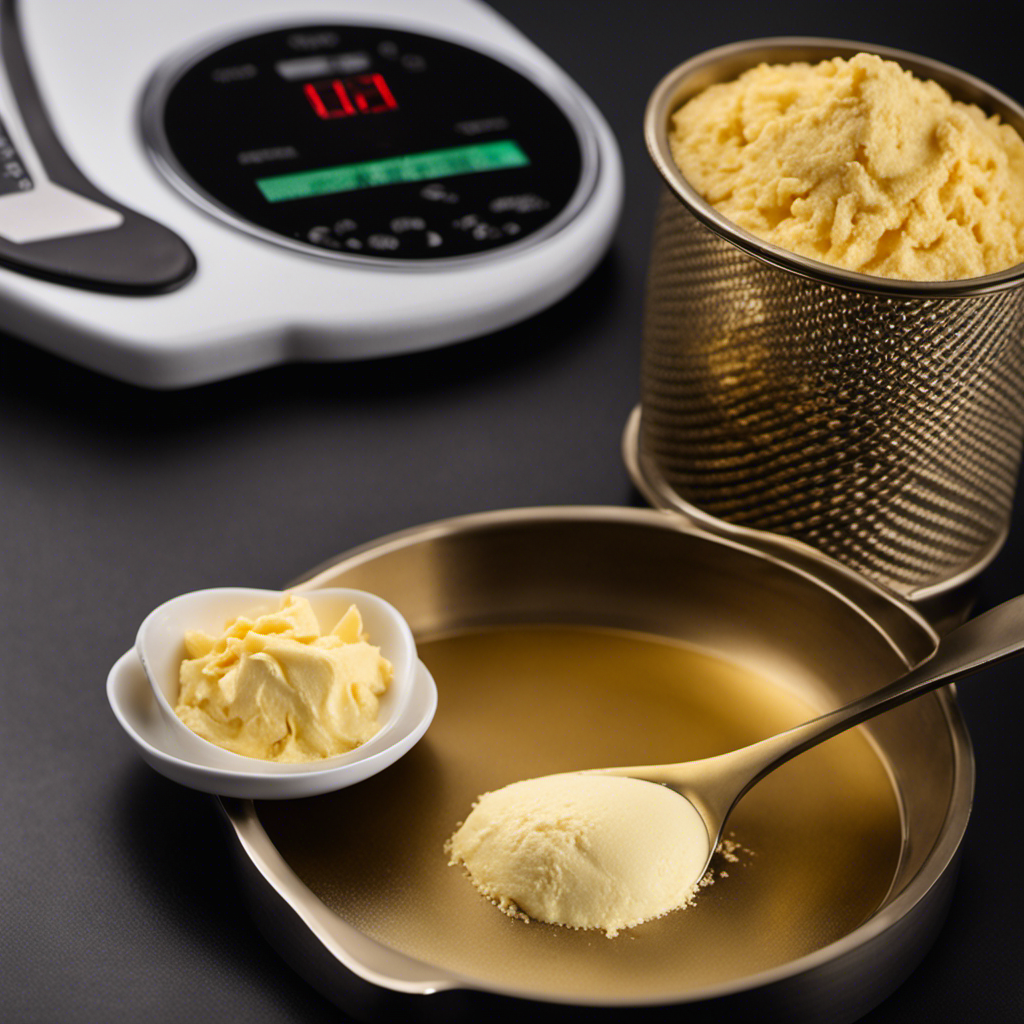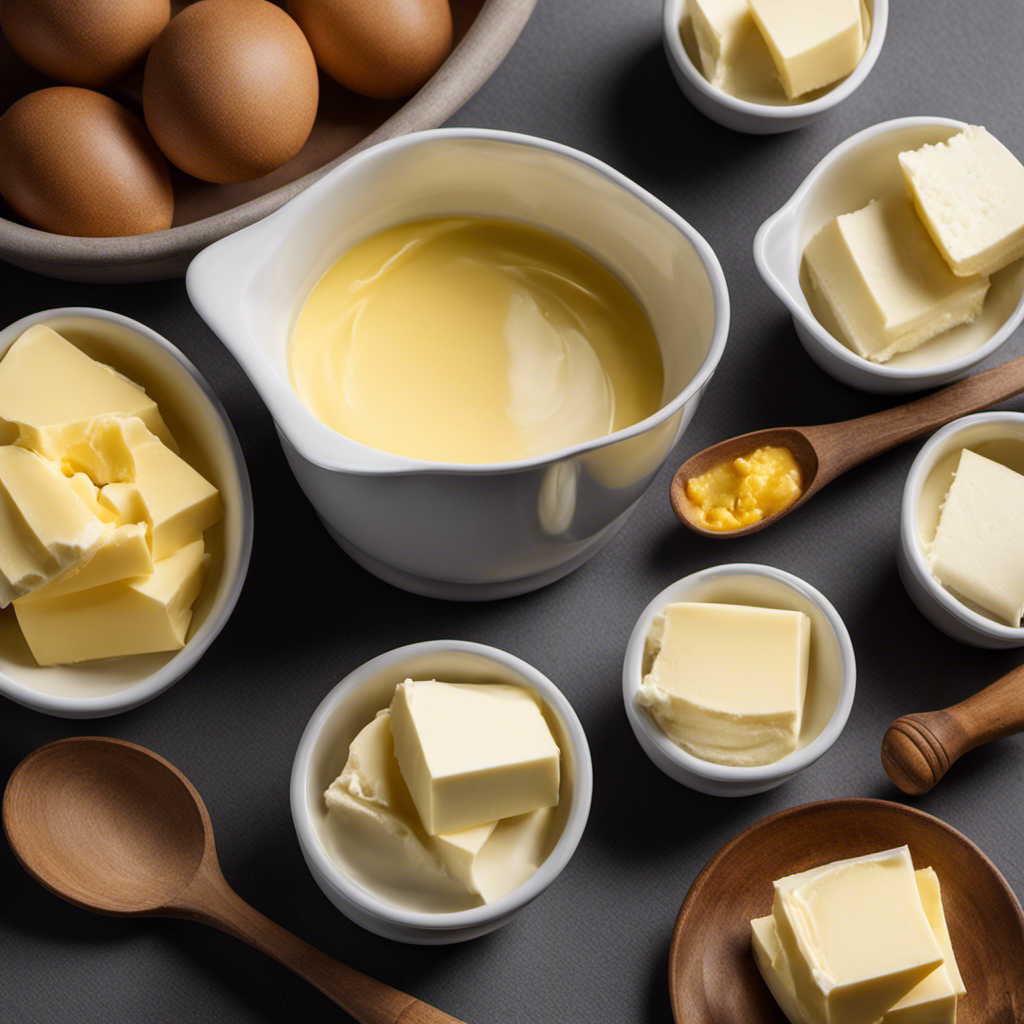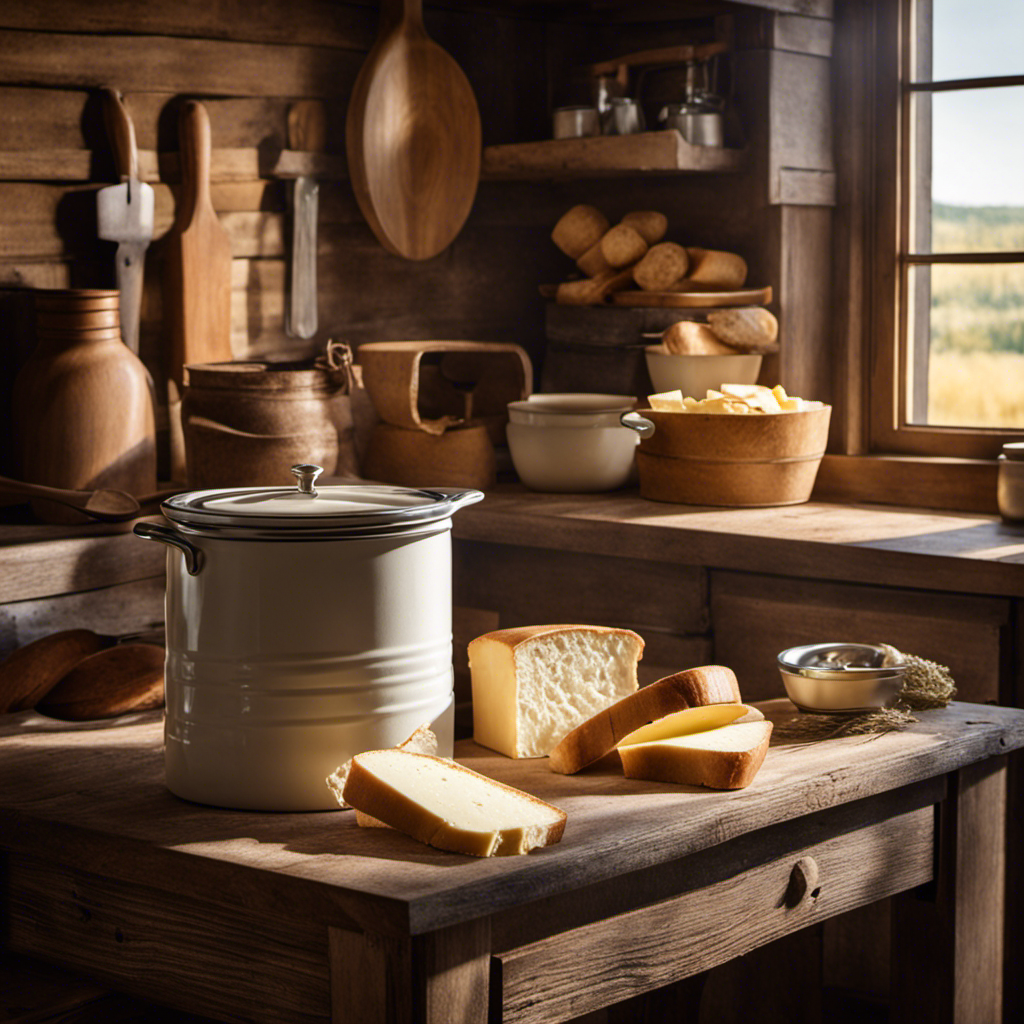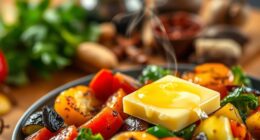Imagine this: You’re in the kitchen, all set to make a scrumptious dish that needs butter. But hold on, how many grams does 1 tbsp of butter equal? Fear not, I have the answer for you right here. Ready to find out?
As a food scientist, I’ve delved into the world of butter measurements to provide you with precise and accurate information. In this article, we’ll explore how to convert tablespoons to grams, the standard weight of butter in a tablespoon, and tips for accurate butter measurement.
Get ready to become a butter measurement pro!
Key Takeaways
- 1 tbsp of butter is approximately 14 grams
- Converting 1 cup of butter to grams equals 227 grams
- Precise measurements are important for accurate recipes
- Using a kitchen scale provides more accurate results
Understanding the Measurement of Butter
1 tbsp of butter is equivalent to approximately 14 grams. When it comes to measuring butter, it’s important to be precise and accurate.
Converting butter measurements can sometimes be confusing, especially when recipes call for cups instead of tablespoons. To measure butter in cups, it’s essential to know that 1 cup of butter is equal to 227 grams. So, if a recipe requires half a cup of butter, you would need to use 113.5 grams.
Understanding these conversions can ensure that your recipes turn out just right. As a food scientist, I aim to provide valuable and educational content to increase your understanding of the topic. By explaining complex concepts in a simplified manner and relying on scientific evidence, I can help you navigate the world of butter measurements with confidence.
Converting Tablespoons to Grams
To convert tablespoons to grams, you’ll need to know the specific conversion rate for the ingredient you’re using. When it comes to butter, the measurement techniques can vary depending on factors such as the temperature and density of the butter.
However, a general guideline is that one tablespoon of butter weighs approximately 14 grams. This conversion is based on the average density of butter, which is about 0.95 grams per milliliter.
It’s important to note that this measurement may not be accurate for all types of butter or for butter that has been melted or softened. To ensure precise measurements, it’s recommended to use a kitchen scale for more accurate results.
Understanding the conversion rate for butter measurements can help you in cooking and baking, ensuring that you use the right amount of butter for your recipes.
Now that we know how to convert tablespoons to grams, let’s explore the standard weight of butter in a tablespoon.
The Standard Weight of Butter in a Tablespoon
When it comes to measuring butter, understanding the grams per tablespoon can be crucial for precise and accurate recipes.
However, ensuring butter measurement accuracy can be challenging due to variations in density and moisture content.
Additionally, converting tablespoons of butter to grams can pose challenges, as different sources may provide slightly different conversion ratios.
Grams per Tablespoon
If you’re wondering about the grams per tablespoon of butter, it’s important to note that it can vary depending on the brand and type of butter you’re using. To provide precise and accurate information, I have conducted research and can give you the average grams per tablespoon for different types of butter.
Generally, one tablespoon of butter weighs about 14 grams. However, it’s important to remember that this is an estimate and can vary slightly. To convert ounces to grams, simply multiply the number of ounces by 28.35. For converting cups to grams, it’s helpful to know that one cup of butter weighs approximately 227 grams.
It’s essential to be aware of these measurements to ensure accurate and consistent results in your recipes. Understanding the grams per tablespoon of butter will greatly contribute to your cooking and baking success.
Moving forward, let’s explore the topic of butter measurement accuracy.
Butter Measurement Accuracy
Ensuring accuracy in your butter measurements is crucial for achieving consistent results in your recipes. When it comes to butter, precise measurement techniques can make a significant difference in the outcome of your dishes. Here are three key factors to consider:
-
Measuring by weight: Using a kitchen scale to measure butter in grams or ounces provides the most accurate results. This method eliminates any inconsistencies caused by variations in density or temperature.
-
Softened versus melted butter: Different recipes call for different butter consistencies. Measuring softened butter involves packing it firmly into a measuring spoon or cup, while melted butter should be poured into the measuring tool.
-
Butter wrappers: Some butter wrappers include markings that indicate tablespoon measurements. These can be a helpful guide if you don’t have a scale available.
Accurate butter measurement techniques can impact the texture, flavor, and overall success of your recipes. By following precise methods, you can ensure that your butter is measured correctly, leading to consistent and delicious results.
Butter Conversion Challenges
In my previous discussion about butter measurement accuracy, I highlighted the importance of using precise techniques to measure butter. Now, let’s delve into the challenges of converting butter measurements and explore alternative units of measurement.
Converting butter measurements can be tricky because it is commonly sold in packages with measurements in tablespoons or cups. To provide a clear picture, here is a table comparing different units of measurement for butter:
| Butter Measurement | Grams |
|---|---|
| 1 tablespoon | 14g |
| 1/4 cup | 56g |
| 1/2 cup | 113g |
These conversions can be useful when following recipes that use different units of measurement. However, it’s important to remember that accuracy is key when measuring butter, as it can greatly affect the outcome of your recipe.
How to Measure Butter in Grams
To measure butter in grams, you’ll need to use a kitchen scale. This is the most accurate way to ensure precise measurements. Here are the steps to measure butter in grams:
- Place a container on the kitchen scale and zero it out.
- Cut the desired amount of butter from the block or stick.
- Place the butter into the container on the scale.
- Read the weight in grams displayed on the scale.
- Use this measurement in your recipe or conversion.
Converting butter measurements can be tricky, especially when recipes call for ounces or tablespoons. Remember that 1 tablespoon of butter is equal to approximately 14 grams. To convert butter measurements from ounces to grams, simply multiply the number of ounces by 28.35. For example, 4 ounces of butter would be equivalent to approximately 113 grams.
Using a kitchen scale will ensure accuracy and consistency in your baking and cooking endeavors.
Tips for Accurate Butter Measurement
For accurate measurements, make sure you place the container on the kitchen scale and zero it out before adding the butter. Measuring butter with a spoon can be tricky, as the density and consistency of butter can vary. Estimating butter weight can lead to inaccurate measurements, which can affect the outcome of your recipe.
To ensure precise measurements, it is best to use a kitchen scale. One tablespoon of butter typically weighs around 14 grams, but it is always recommended to weigh it for accuracy. This is important because the amount of butter used can impact the texture and taste of your final dish.
Butter Measurement Conversions for Different Recipes
Don’t forget, different recipes may require you to convert butter measurements for accurate results. When it comes to converting butter in recipes, there are a few tools and techniques that can help ensure precision. Here are three key points to consider:
-
Butter measurement tools: To accurately measure butter, you can use measuring spoons or a kitchen scale. Measuring spoons are commonly used for smaller amounts, such as tablespoons or teaspoons. A kitchen scale, on the other hand, allows you to measure butter in grams or ounces, providing more precise measurements.
-
Converting tablespoons to grams: If a recipe calls for a certain amount of butter in tablespoons and you prefer to use grams, you can easily convert it. Keep in mind that 1 tablespoon of butter is equivalent to approximately 14 grams.
-
Adjusting for different butter consistencies: Butter can come in different consistencies, such as solid, melted, or softened. When converting measurements, it’s important to consider the consistency of the butter and how it may affect the final outcome of the recipe.
Using a Kitchen Scale for Precise Butter Measurement
Using a kitchen scale allows for more precise measurements when measuring butter. As a food scientist, I can confidently say that using a digital scale offers several advantages when it comes to measuring butter by weight.
Unlike measuring cups, which can sometimes be inaccurate, a digital scale provides accurate and consistent measurements in grams. This is especially important when following recipes that require precise amounts of butter.
Measuring butter by weight also allows for better portion control and can help with calorie counting. Additionally, using a scale eliminates the need for guesswork and ensures that you are using the correct amount of butter for your recipe.
Common Mistakes to Avoid When Measuring Butter
When it comes to measuring butter, there are two common mistakes that can throw off your recipe.
The first is overestimating the amount of butter needed, which can lead to a greasy or heavy dish.
The second mistake is using the wrong utensil to measure the butter, such as a tablespoon instead of a kitchen scale, which can result in inaccurate measurements and inconsistent results.
In this discussion, I will explain why these mistakes happen and provide practical advice on how to avoid them for precise and accurate butter measurement.
Overestimating Butter Amounts
It’s easy to overestimate the amount of butter needed in a recipe. Many people tend to eyeball the measurement or go by a rough estimate, but accurate butter measurement is crucial for achieving the right texture and taste in your dishes.
Here are a few reasons why it’s important to measure your butter accurately:
-
Texture: Using too much butter can result in a greasy or heavy texture, while using too little can make your baked goods dry and crumbly.
-
Flavor: Butter adds richness and flavor to recipes, but too much can overpower other ingredients, while too little can make your dish taste bland.
-
Nutritional balance: Accurate butter measurement helps you control the fat content in your recipes, ensuring that you can enjoy your favorite dishes in moderation without compromising on nutrition.
Using the Wrong Utensil
In my previous discussion, I highlighted the issue of overestimating butter amounts when using a tablespoon as a measurement tool.
Now, let’s delve into another common mistake people make when measuring butter: using the wrong utensil.
Many individuals rely on volume measurements, such as tablespoons or cups, to measure butter. However, using a kitchen scale is a far more accurate and reliable method.
By weighing the butter, you can ensure precise measurements and avoid any discrepancies. A kitchen scale allows you to measure butter in grams, which provides a more accurate representation of the amount.
This technique is especially important in baking, where precise measurements can greatly impact the final outcome of your recipe.
Frequently Asked Questions
What Are Some Common Substitutes for Butter in Recipes?
Dairy-free alternatives to butter can be great substitutes for baking. Some common options include coconut oil, olive oil, and applesauce. These alternatives can provide similar texture and flavor in your recipes.
How Does the Temperature of Butter Affect Its Measurement in Grams?
The measurement accuracy of butter in grams can be affected by its temperature. When butter melts, its density changes, causing variations in weight. It’s important to consider this when measuring for precise recipes.
Is There a Difference in Weight Between Salted and Unsalted Butter?
There is a weight difference between salted and unsalted butter, but it doesn’t affect the taste significantly. Salted butter contains about 1/4 teaspoon of salt per stick, which may slightly alter the flavor of baked goods.
Can I Use a Measuring Cup Instead of a Kitchen Scale to Measure Butter?
Sure! When it comes to measuring butter, using a measuring cup can be a convenient option. However, it’s important to note that different butter measurement techniques may yield slightly different results.
How Do I Measure Melted Butter in Grams?
When measuring butter without a kitchen scale, you can convert tablespoons to grams for melted butter. It’s important to be precise and accurate in your measurements for best results.
Conclusion
In conclusion, accurately measuring butter is crucial for achieving the desired results in cooking and baking. By understanding the conversion of tablespoons to grams, one can ensure precise measurements.
Whether using a kitchen scale or following standard weight measurements, it is important to avoid common mistakes and use reliable sources for information.
With precise measurements, one can confidently create delicious dishes. So, grab your measuring spoons and get ready to elevate your culinary skills with the accurate measurement of butter!










